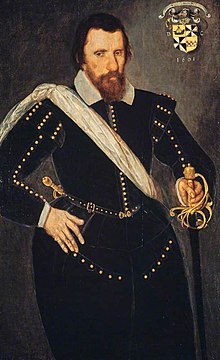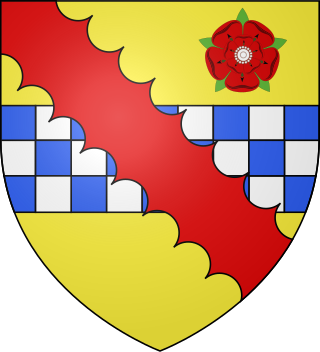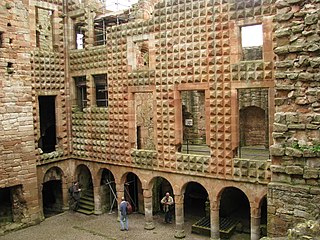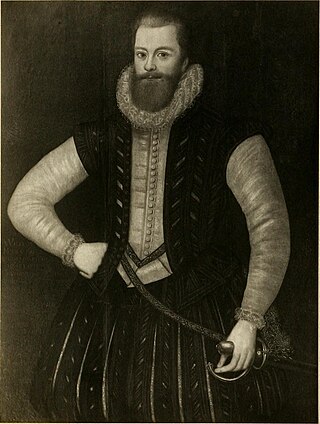

John Murray, 1st Earl of Tullibardine (d. 5 July 1613 ) was a Scottish courtier and leader of the Clan Murray.


John Murray, 1st Earl of Tullibardine (d. 5 July 1613 ) was a Scottish courtier and leader of the Clan Murray.
He was born c. 1550, the son of Sir William Murray of Tullibardine and Agnes Graham, a daughter of William Graham, 2nd Earl of Montrose and Janet Keith. His paternal aunt was the influential Annabell Murray, Countess of Mar.
In August 1580 his father resigned the office of Comptroller of Scotland and James VI gave it to him. [1]
Murray was a Master of the Household to James VI of Scotland. His uncle Mungo Graham of Rathernis was another courtier who shared this role. [2]
His brother, Captain George Murray, accompanied James VI in Denmark in 1590. [3]
In September 1590 Tullibardine and his brother-in-law Robert Murray of Abercairnie were guests of the Laird of Glenorchy at Balloch, now Taymouth Castle. [4]
James VI often visited him at Tullibardine or Gask. James VI attended the wedding of Lilias Murray and John Grant of Freuchie on 21 June 1591. [5] James VI performed in a masque with his valet, probably John Wemyss of Logie. [6] They wore Venetian carnival masks and helmets with red and pink taffeta costumes. [7] James VI was at Tullibardine for New Year in 1592. [8]
On 20 July 1593 he hit William Edmondstone of Duntreath in the face with the hilt of his sword during a session of the Parliament in the Tolbooth of Edinburgh, in the king's presence. [9]
Murray fought at the Battle of Glenlivet against George Gordon, 1st Marquess of Huntly, and Francis Hay, 9th Earl of Erroll.
The king invited the Earl of Mar to join them "making merry" at Gask on 28 July 1595. [10] This was probably the "in-fare" feast for the wedding of Anne Murray. [11] James VI stayed at Tullibardine for the first week in January 1598. [12] In April 1598 the Duke of Holstein, brother of Anne of Denmark visited Tullibardine on a progress with the Duke of Lennox. [13]
Alexander Menzies of Weem complained in January 1599 that Murray had welcomed Donald Menzies and John Dow MacWilliam alias MacGregor, two thieves, as his household men and servants. MacWilliam had broken into the Place of Weem, now called Castle Menzies, and rescued Donald Menzies from a cell. [14]
He consolidated his position as head of the family with two "bands of association" in 1586 and 1599 in which he was recognized as chief by numerous Murray lairds including the Morays of Abercairny in Perthshire. [15]
In April 1604 he was made Lord Murray of Tullibardine, on 10 July 1606 he became Earl of Tullibardine. [16]
Murray married Catherine Drummond, daughter of David, 2nd Lord Drummond (a great grandson of Colin Campbell, 1st Earl of Argyll) and Lilias Ruthven. Their children included;

Alexander Seton, 1st Earl of Dunfermline (1555–1622) was a Scottish lawyer, judge and politician. He served as Lord President of the Court of Session from 1598 to 1604, Lord Chancellor of Scotland from 1604 to 1622 and as a Lord High Commissioner to the Parliament of Scotland.

Walter Stewart, 1st Lord Blantyre was a Scottish courtier, politician and judge. Educated with James VI under George Buchanan at Stirling Castle, he was a gentleman in the king's chamber, Knight of Cardonald, Prior of Blantyre, Keeper of the Privy Seal of Scotland from 1582 to 1596, an Extraordinary Lord of Session from 1593, an Octavian from 1596, and Treasurer of Scotland from 1596 to 1599
John Graham, 3rd Earl of Montrose was a Scottish peer and Chancellor of the University of St Andrews from 1599 to 1604. He was Lord High Commissioner to the Parliament of Scotland, from 1605 to 1606.

Francis Stewart, 5th Earl of Bothwell, was Commendator of Kelso Abbey and Coldingham Priory, a Privy Counsellor and Lord High Admiral of Scotland. He was a notorious conspirator who led several uprisings against his first cousin, King James VI, all of which ultimately failed, and he died in poverty in Italy after being banished from Scotland. Francis's maternal uncle, the 4th Earl of Bothwell, was the chief suspect in the murder of James VI's father, Lord Darnley.
Anne Lyon, Countess of Kinghorne, was a Scottish courtier said to be the mistress of James VI of Scotland.
Sir Richard Cockburn of Clerkington, Lord Clerkintoun (1565–1627) was a senior government official in Scotland serving as Lord Privy Seal of Scotland during the reign of James VI.

Tullibardine is a location in Perth and Kinross, Scotland, which gives its name to a village, a castle and a grant of nobility.
Lady Lilias Grant was a Scottish letter-writer and matriarch of the Grant clan of Freuchie.

John Wemyss younger of Logie, (1569-1596), was a Scottish courtier, spy, and subject of the ballad "The Laird o Logie", beheaded for plotting to blow up a fortification at Veere in the Netherlands
John Fleming, 6th or 7th Lord Fleming (1567–1619), Scottish aristocrat and diplomat.
John Stewart, 5th Earl of Atholl, (1563–1595) was a Scottish landowner.
John Grant of Freuchie was a Scottish landowner.

William Murray, 2nd Earl of Tullibardine was a Scottish landowner and courtier.

Patrick Lyon, 1st Earl of Kinghorne was a Scottish landowner.
William Murray of Tullibardine was a Scottish courtier and leader of the Clan Murray.
John Elphinstone of Selmes and Baberton (1553-1614) was a Scottish landowner and courtier.
Tullibardine Castle was a castle located in the village of Tullibardine, 2 miles (3.2 km) north of Auchterarder in Perth and Kinross, Scotland.

Sir Duncan Campbell, 1st Baronet of Glenorchy (1545-1631) was a powerful Clan Campbell chieftain, landowner, courtier and favourite of Queen Anne of Denmark. He was the progenitor of the Earls of Breadalbane and Holland.
Marie Ruthven, Countess of Atholl, was a Scottish aristocrat.

John Grant of Freuchie (1596-1637) was a Scottish landowner.